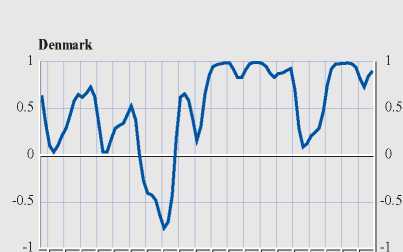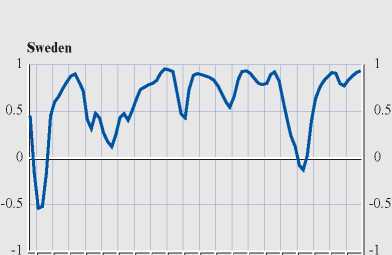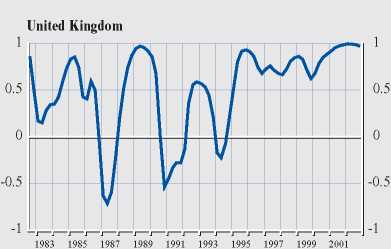Chart 10 Business cycle synchronisation


1983 1985 1987 1989 1991 1993 1995 1997 1999 2001
1983 1985 1987 1989 1991 1993 1995 1997 1999 2001

Sources: Eurostat, NCBs, ECB calculations.
Note : Business cycle correlation is measured by the correlation coefficient of an 11 -quarter rolling window between the business cycle
component of each individual country and the (available) business cycle component for the rest of the EU countries (applying country weights
to each individual EU country business cycle component).
3.3.1 AGGREGATE VERSUS SECTORAL BUSINESS
CYCLE SYNCHRONISATION
Measuring business cycle correlations for each
available country against the average cycle of
the remaining EU countries, Chart 10 gives an
overview of the evolution of business cycle
synchronisation.
The Chart confirms earlier analyses in this area
showing that business cycle synchronisation
increased at the beginning of the 1990s and
continued throughout the decade, despite a
short period of relatively lower synchronisation
in the aftermath of the Asian and Russian crises
(1997 and 1998) that affected Germany
relatively more strongly than the other EU
countries.51 This de-synchronisation was
particularly important for some smaller EU
countries (Denmark, Sweden), where even
some divergence was observed in 1997, but also
for countries like France and Italy, albeit on a
smaller scale.
Similarly to the aggregate business cycle,
synchronisation can also be measured on the
sectoral level, as presented in Table 10. In this
table, correlation coefficients for each sector
between individual countries and the EU
countries average are presented:
51 This also holds true for those EU countries for which the analysis
could not be carried out on account of missing data. Looking at
annual data over a longer period, Belo (2001) detects cyclical
convergence for Ireland, Portugal and Greece over the period
1960-1999 yielding qualitatively speaking the same conclusions
as in this report; F. Belo (2001), “Some facts about the cyclical
convergence in the euro zone”, Banco de Portugal Working
Paper, 7-01.
44
ECB
Occasional Paper No. 19
July 2004
More intriguing information
1. The name is absent2. Convergence in TFP among Italian Regions - Panel Unit Roots with Heterogeneity and Cross Sectional Dependence
3. Firm Creation, Firm Evolution and Clusters in Chile’s Dynamic Wine Sector: Evidence from the Colchagua and Casablanca Regions
4. Cyber-pharmacies and emerging concerns on marketing drugs Online
5. Migration and Technological Change in Rural Households: Complements or Substitutes?
6. The name is absent
7. Testing the Information Matrix Equality with Robust Estimators
8. The name is absent
9. The name is absent
10. Chebyshev polynomial approximation to approximate partial differential equations